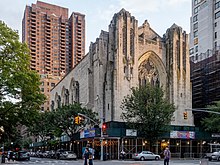Church of the Heavenly Rest
Church in Manhattan, New York From Wikipedia, the free encyclopedia
Church in Manhattan, New York From Wikipedia, the free encyclopedia
The Church of the Heavenly Rest is an Episcopal church located on the corner of Fifth Avenue and 90th Street, opposite Central Park and the Carnegie Mansion, on the Upper East Side of New York City. The church is noted for the architecture of its building, its location on Museum Mile, its outreach, thrift, music and arts programs, and some of its congregation members.
| Church of the Heavenly Rest | |
|---|---|
 | |
 | |
| Location | 1085 Fifth Avenue, New York City |
| Country | United States |
| Denomination | Episcopal Church (United States) |
| Website | heavenlyrest.org |
| History | |
| Founded | 1865 |
| Architecture | |
| Heritage designation | National Register of Historic Places, 1921 |
| Architect(s) | Mayers, Murray & Phillip |
| Style | Neo-Gothic style |
| Completed | 31 March 1929 |
| Administration | |
| Diocese | Diocese of New York |
| Clergy | |
| Bishop(s) | Matthew Heyd |
| Rector | Rev. Kate Malin |
| Assistant priest(s) | Rev. Margaret Rose, Rev. Robert M. Pennoyer III, Rev. Dr. Meredith Hawkins |
| Curate(s) | Rev. Cindy Stravers |
| Laity | |
| Director of music | Janet Yieh |
In 2020, it reported 1,866 members, but no figures for attendance or plate and pledge income.

The church was founded in 1865 (officially established in 1868) by American Civil War veterans, with the assistance of the Reverend Robert Shaw Howland. It was meant as a memorial to soldiers who had died in the Civil War. By 1900, the church had amassed close to 1000 members. The church was originally located on Fifth Avenue and 45th Street before moving to its present site.[1]
The land for the current site was sold to the church in 1926 by Louise Whitfield Carnegie, Andrew Carnegie's widow. Carnegie purchased the site in 1917 for $1.7 million shortly after a sign was erected reading "for sale without restrictions"; his ownership prevented apartment house development there that would intrude on his mansion's surroundings, but the site remained undeveloped with only a few billboards and a lemonade stand on one of the city's most expensive addresses. Its subsequent sale to the church carried the restrictions that the land could only be used "for a Christian church no higher than 75 feet, exclusive of steeple" through 1975.[2]
The limestone church was designed in the neo-Gothic style by the firm Mayers, Murray & Phillip, successors to Bertram Goodhue. Goodhue died before the first stone was laid. Mayers, Murray & Phillip took over construction.[3] It opened on Easter 1929, seating 1,050, at a cost of $3.2 million. Sculpture was to be executed by Malvina Hoffman, Lee Lawrie, and other artists.[2] The architecture and sculpture combined neo-Gothic styles with Art deco details.[1] However, over two-thirds of the sculptural program was never executed; sculptor Janet Scudder withdrew from a commission in 1928 after it was downsized. The Stock Market Crash of 1929 ended other work, and the blocky limestone facade was retained without sculpture.[4]
Innovative design features included unobstructed views of the altar, indirect lighting and a high-tech sound system.[2] The building was listed on the National Register of Historic Places in 2021.[5]
The church has a number of choirs, including boys' and girls', a mixed adult choir, and a bell choir. For its patronal feast, which is All Saints' Day, the hymns "For All the Saints" and "I Sing a Song of the Saints of God" are commonly sung.
The funeral of Chester A. Arthur, former President of the United States, was held at the church in 1886,[6] and the ashes of the actress Gloria Swanson were interred there in 1983.[7] The Rt. Rev. Matthew Heyd, 17th Bishop of New York, was rector of the church from 2013 to 2023.
The church is featured in a scene in the 1997 film The Devil's Advocate starring Keanu Reeves. In the film, Kevin finds his wife Mary Ann sitting on a bench in the church, where she reveals her naked body to be covered in cuts and bruises, accusing Milton (Satan) of raping her.[8]
Seamless Wikipedia browsing. On steroids.
Every time you click a link to Wikipedia, Wiktionary or Wikiquote in your browser's search results, it will show the modern Wikiwand interface.
Wikiwand extension is a five stars, simple, with minimum permission required to keep your browsing private, safe and transparent.